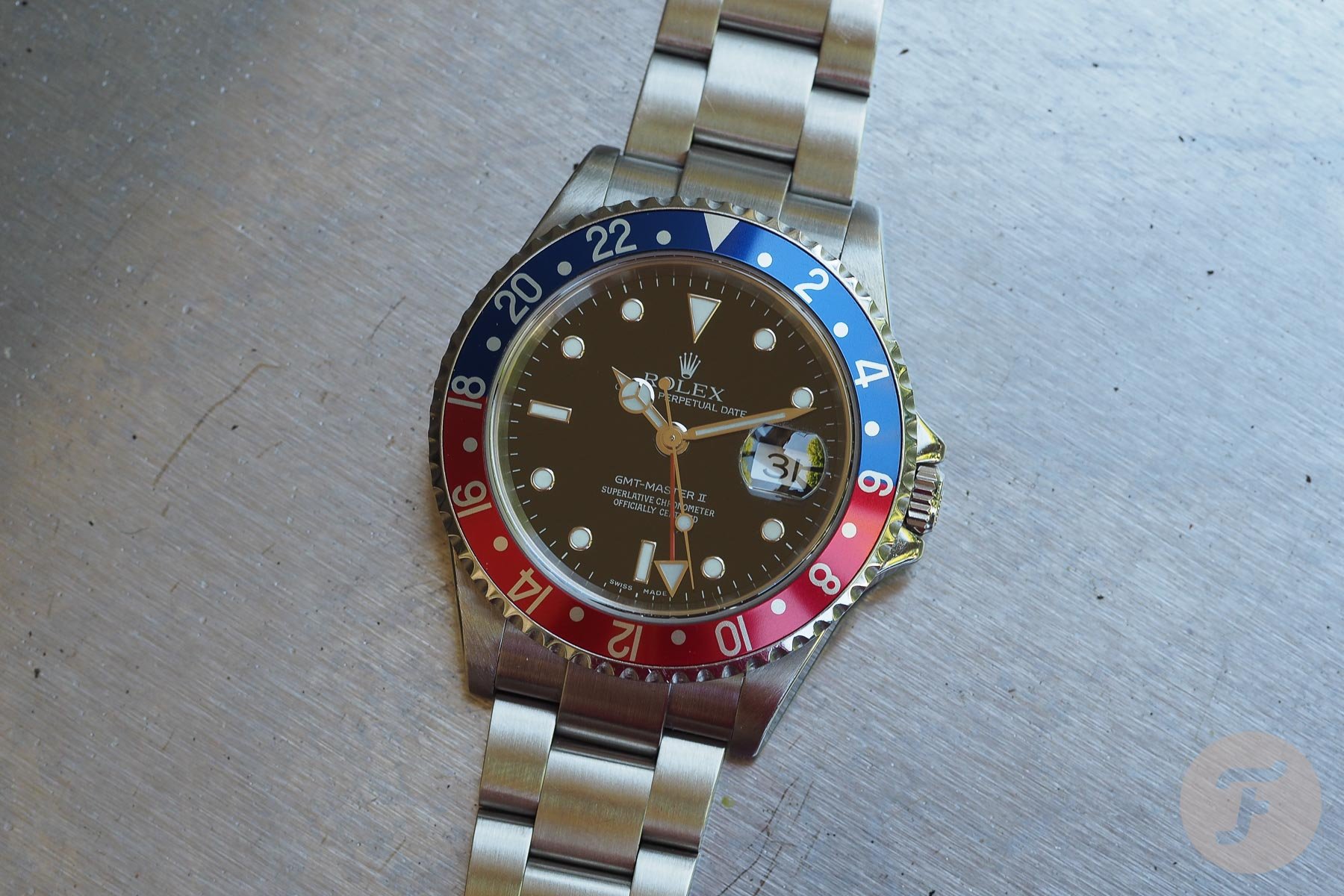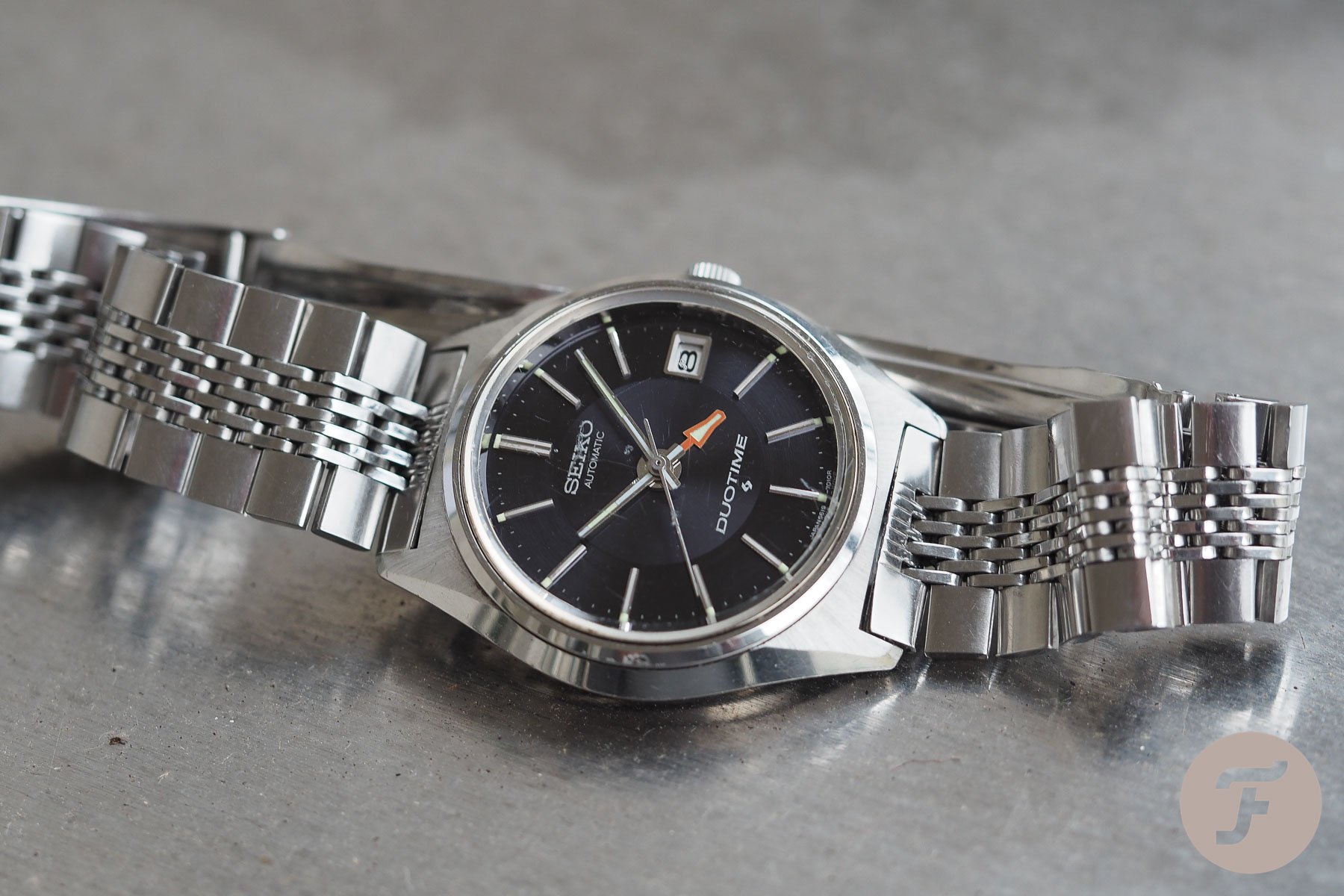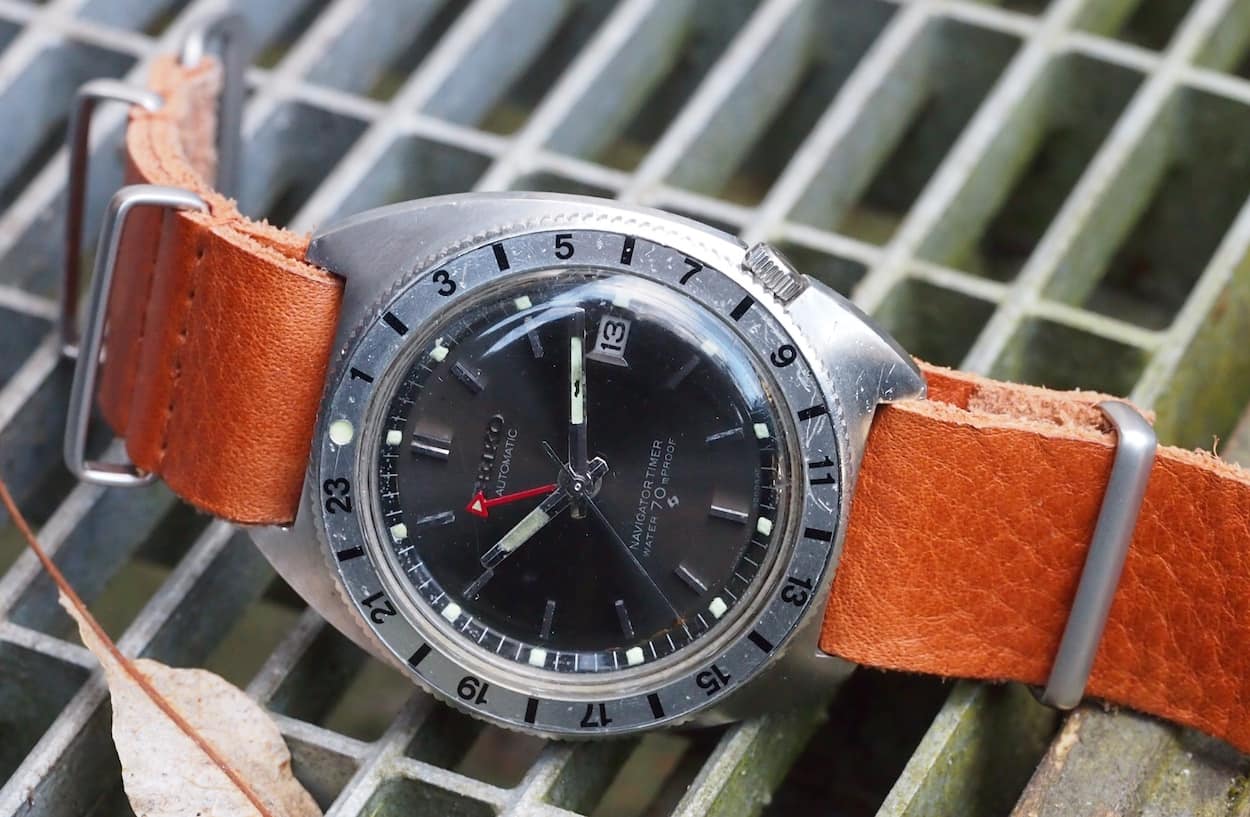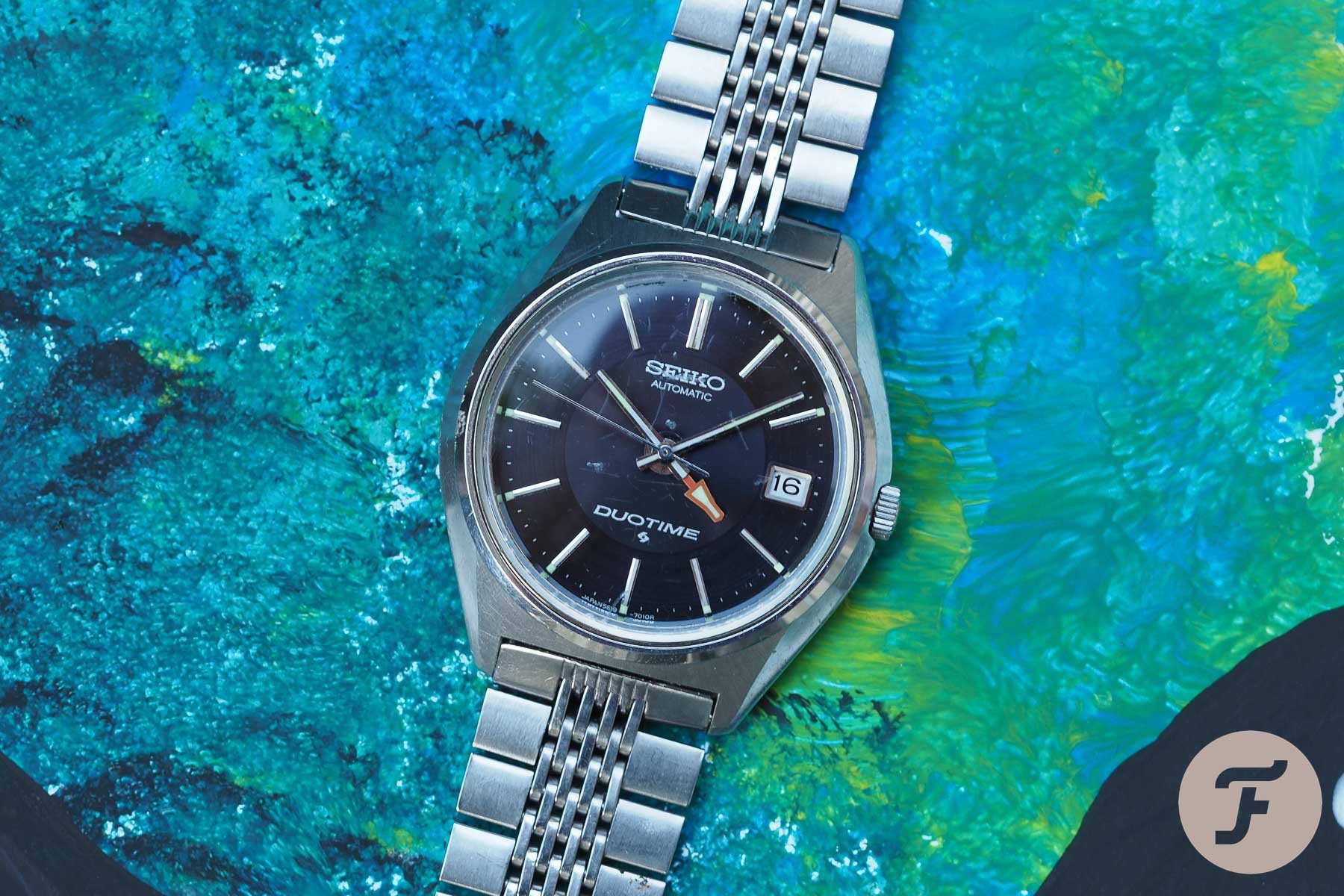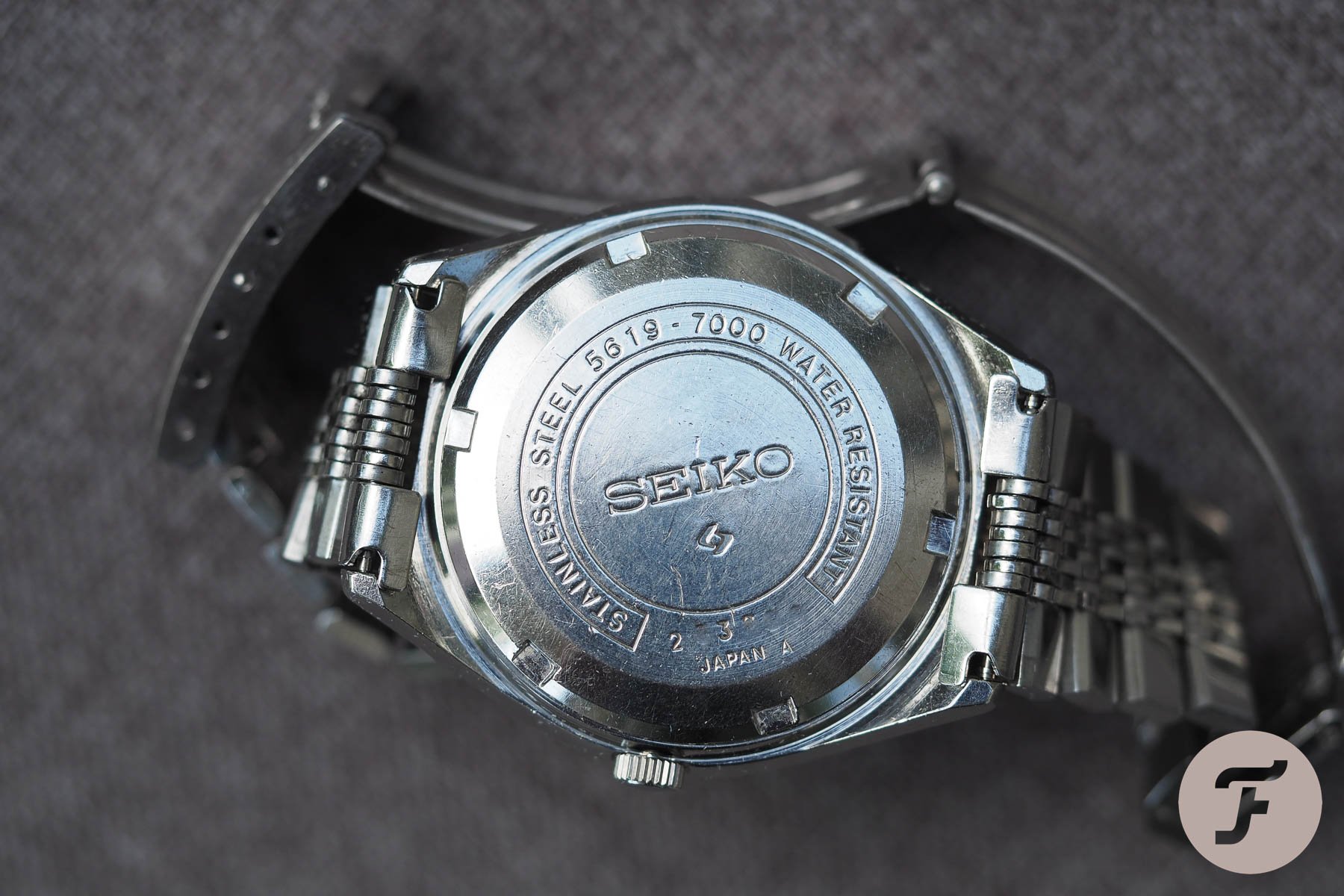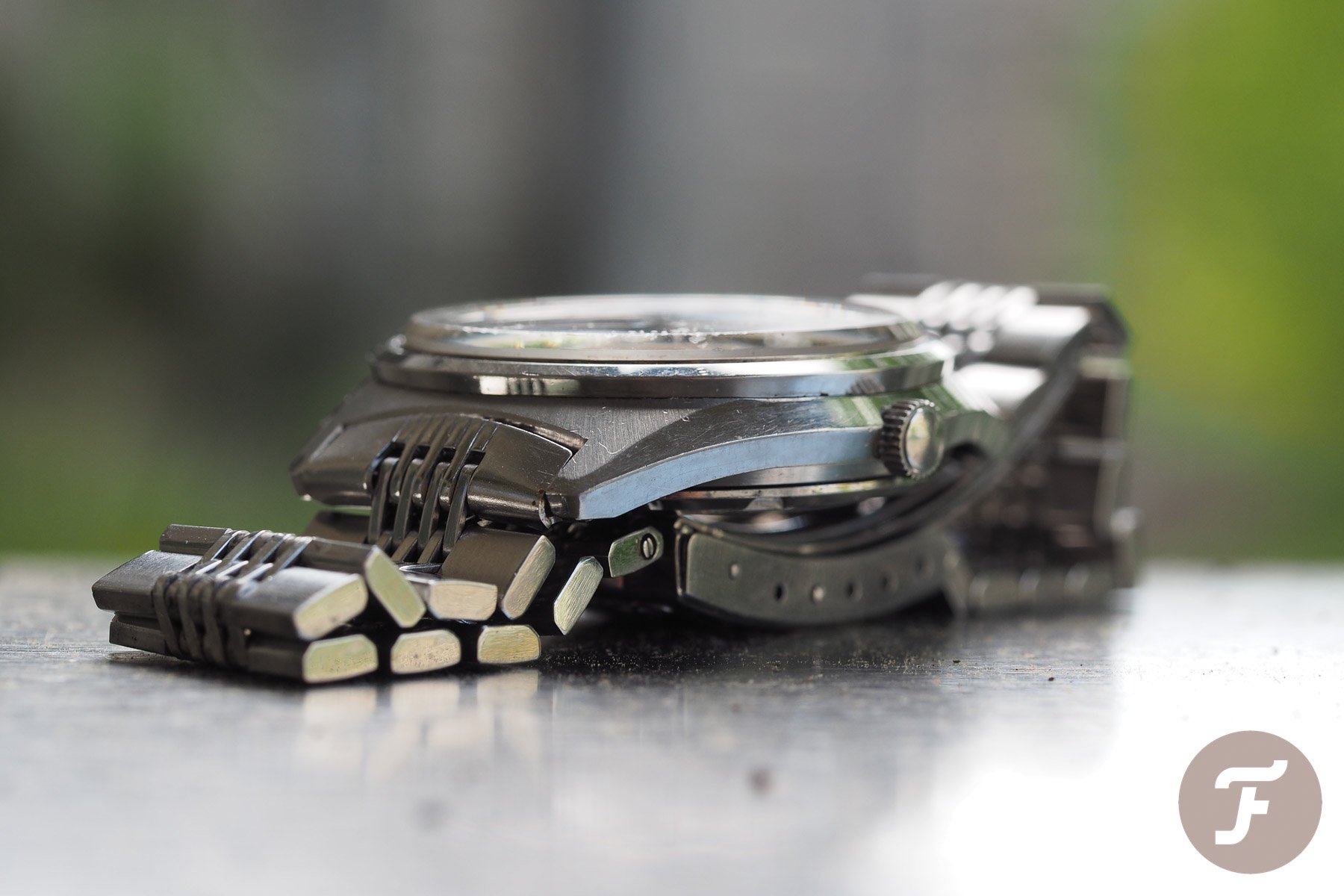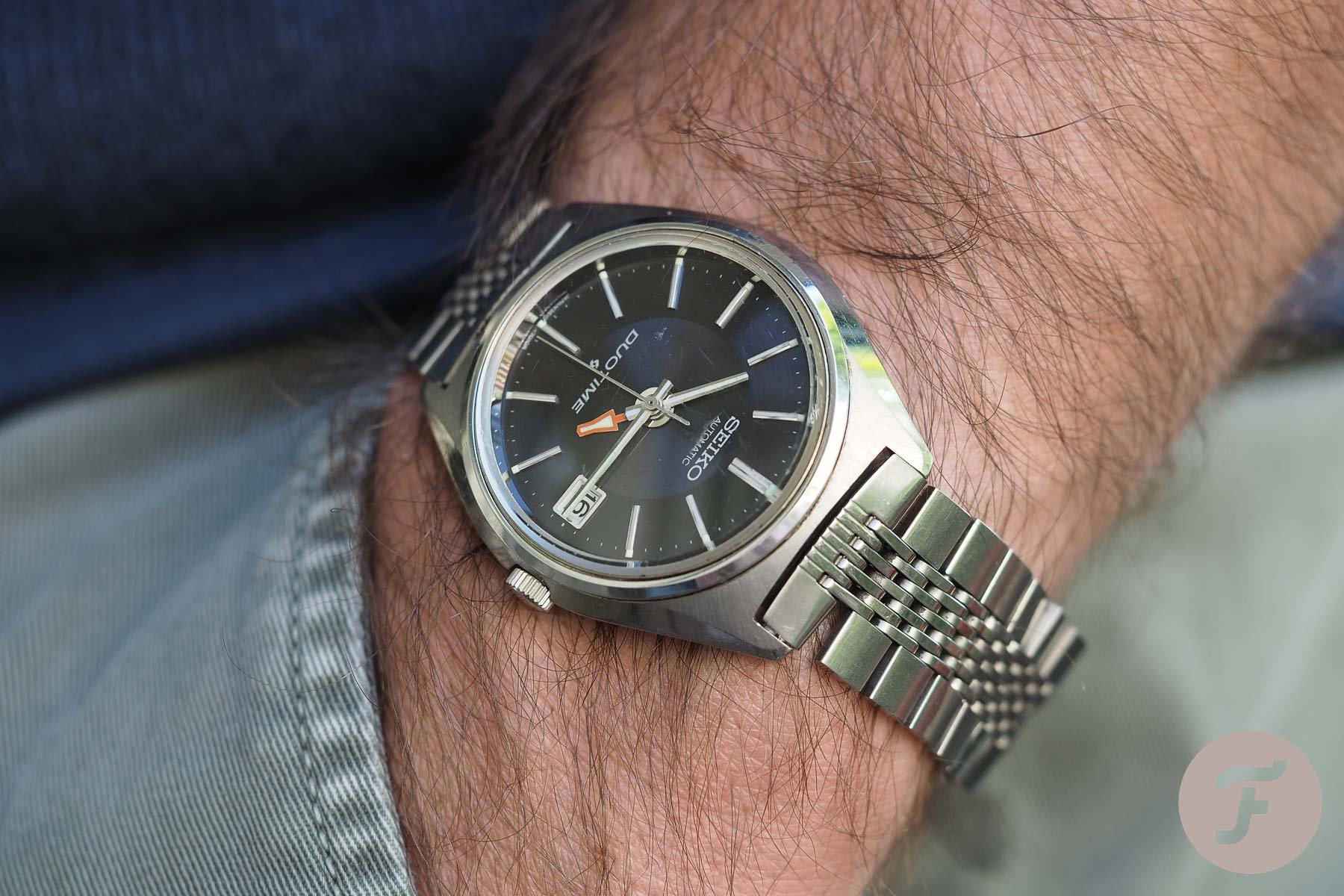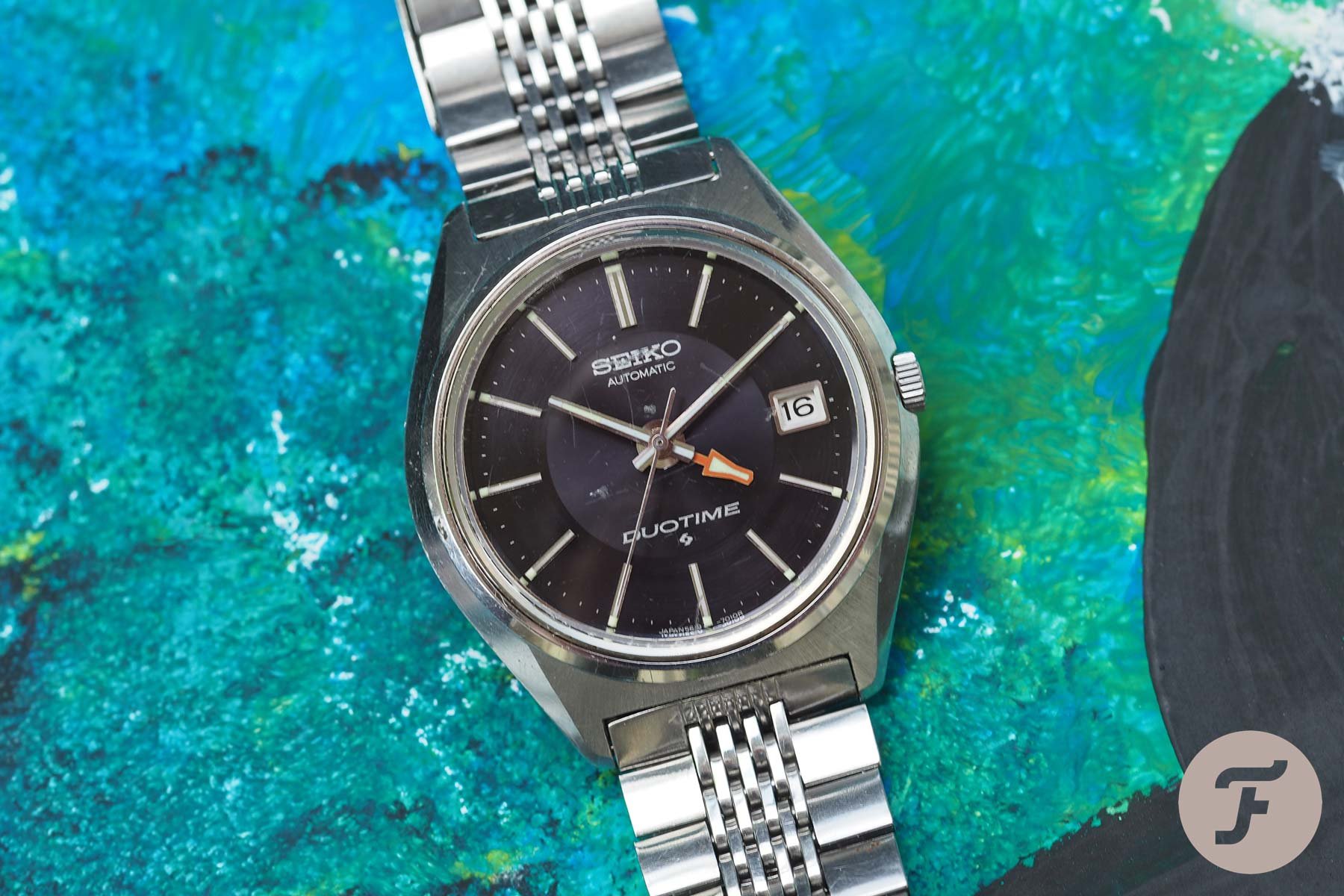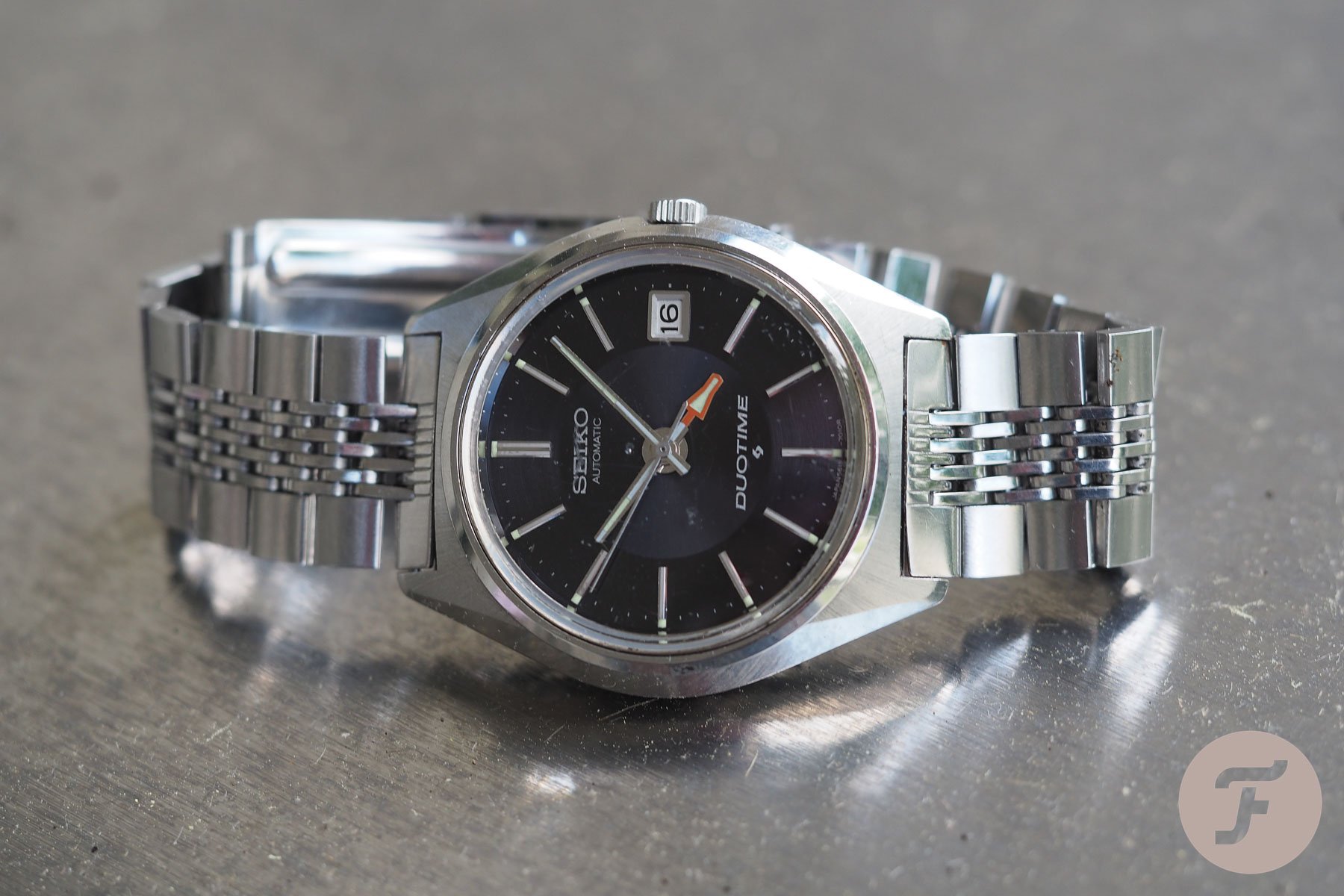Early Innovation: The Vintage Seiko Duotime 5619-7000
It’s time for another look at a vintage Japanese watch, and this time, it’s the Seiko Duotime 5619-7000. This was a unique series of watches that Seiko produced from 1972 until 1974, and they are among the earliest pieces with an independent 12-hour hand. This lovely feature was well ahead of its time, but the function came with a flaw that we’ll expose (as an aside, a big thanks to my daughter for her wrist modeling above and for taking some wrist shots of me!).
Watches that show multiple time zones are certainly fashionable right now. In fact, they’re so popular that most folks have constructed a mental hierarchy relating to what makes one of these watches worthwhile. Does your new watch feature an independent 12-hour hand? This is the gold standard. Do you “get by” with a lowly piece where the 24-hour hand can be changed? Alas, your membership application to the country club has been declined. If, for heaven’s sake, you must risk marring a manicure by deigning to use your bezel, well, alms are on the way to your hovel. I partially jest…
First, some GMT-related talk and more sarcasm
We mustn’t forget that this ado around how a movement comes together to show another time zone is relatively new. Watches like the Glycine Airman or even the original Rolex GMT-Master are products of the 1950s. Aside from watches with two independent movements inside a case, the two aforementioned pieces are good representatives of how we’ve viewed two time zones for decades. Bezels with hours or cities and hands running at half speed were the norm.
Things changed, though, in a big way with the introduction of the Rolex 3085 caliber in 1983. This movement was used in the first GMT-Master II ever, the “Fat Lady.” We can also thank it for kicking off the modern “office” versus “traveler” GMT battle that has been ripping families apart for decades. You see, the power of the GMT-Master II was to offer an independent quickset local-hour hand. This made it highly convenient for travelers to adjust the watch to a local time zone upon landing. Now, this type of function is common across several brands. It competes with other GMTs that feature a quickset 24-hour hand — this is the office type. Before all of this hullabaloo began in the era of hair gel, were there other forms of quickset hands to show multiple time zones? Absolutely! Enter the Seiko Duotime 5619-7000.
The Seiko Duotime 5619-7000
The Seiko Duotime 5619-7000 that you see above is yet another reminder of the brand’s constant meddling. The Duotime was produced between 1972 and 1974 in two different case styles and several dial colors. It was an oddity, albeit an attractive one, and its brief flicker makes it a real collector’s piece for Seikophiles. The name itself implies two time zones, but there’s a bit more at work here. A casual glance shows a fourth hand in orange, and that’s a real difference that we will soon uncover.
Let’s understand a bit of Seiko history regarding watches with multiple timezone indicators before jumping into the Seiko Duotime 5619-7000. In 1964, as part of the brand’s Tokyo Olympics sponsorship, the 6217-7000 World Time was released. It contained 26 cities on an internal rotating bezel that could be aligned to a 24-hour hand (that reminds me, I need to write an article on one that I own…). Seiko came with several watches like this and made them into the ’70s. Also, there were watches more similar to the GMT-Master, featuring 24-hour internal or external rotating bezels. The Seiko Navigator 6117-8000 above is probably the fan-favorite example of this. On these watches, the arrow hand was not adjustable, and therefore, the bezel was used to show another time zone.
Stepping it up a notch
Let’s return to the Seiko Duotime 5619-7000 and its distinctive orange hand. Critics would liken it to the Rolex Explorer II reference 1655, and they’d be correct from a color perspective. The comparison ends there, though, because this hand is more capable. There’s no 12-hour or 24-hour bezel, which offers a real clue. Yes, it is a quick-setting hand that moves in one-hour increments, so knowing day or night in the other time zone is a requirement. The operation is simple. Pulling the crown out one stop and turning it in one direction sends the orange around in a counterclockwise fashion. Turning the crown in the other direction changes the date. The second crown stop allows the time to be changed as normal.
You’d think that something as “easy” as the independent hand on Seiko Duotime 5619-7000 was commonplace in the ’70s. You’d be wrong, though, because I had a hard time finding other watches from this period or earlier with an independent timezone hand controlled by the main crown. The Omega 910 caliber in the original Flightmaster used a separate crown, as did the Heuer Twin-Time. Longines had some early innovations with its 18.69N caliber used in select pocket watches, but this was not a common movement. So something that we take for granted today such as an independent hand was actually quite rare not so long ago.
A movement for Kings…or Grands
Aside from its quickset hand, the Seiko Duotime 5619-7000 still has a relatively special movement. I say this because it uses the same base caliber found in King and Grand Seiko models from the same period. Granted, those watches, such as the 562x and 564x series, used higher-beat 28,800vph frequencies, but there are still good bones on the Duotime. It runs at 21,600vph, hacks, and has a decent 46-hour power reserve. Interestingly, this movement fell under the “C” accuracy grade for Seiko, which meant that it was adjusted to run at -15 to +25 seconds per month. Not bad at all!
Cool looks with a bit of a ’70s vibe
The Seiko Duotime 5619-7000 has a fair bit of the angular, non-fussy “Grammar of Design” look that I enjoy so much on earlier pieces from the brand. It’s clean and boasts some really nice transitioning on its case from matte to polished surfaces. Also, note the 3 o’clock crown position, which isn’t always the case with Seiko. Of course, the dial is an important detail, and this is where it’s clear that the sterile ’60s have vacated the stage for the funky ’70s.
The official dial color for this watch is navy blue, but to me, it qualifies as purple. It also has some surface changes where the central portion is glossy and the outer ring by the hour markers is brushed. It’s subtle (especially when the Hardlex is scratched like in my example), but it looks great in the light. Thankfully, Seiko opted for very clean hands and indices, which help emphasize the contrast of the smallish orange hand. Too much funk would have confused things beyond legibility.
How does it wear?
Vintage Seiko watches are among my favorites, and one reason is that they typically wear so well. Across the incredible range of watches that I own from this brand, they all seem to fit my wrist. The Seiko Duotime 5619-7000 continues this trend due to its size and its bracelet. This watch sports a 37mm diameter, a lug-to-lug of 42mm, an 11mm thickness, and a lug spacing of 18mm. In essence, it wears a lot like a vintage Rolex Datejust. During my vintage Seiko collecting, I picked up a fair number of watches with their original bracelets. The bulk of them, if I’m being honest, haven’t been great. They’ve been sharp, badly finished, and often ugly. I know the watches weren’t Rolex level in terms of pricing, but vintage Seiko bracelets have largely been underwhelming compared to the watches themselves.
Thankfully, the bracelet on the Duotime is really good! It is stylish and blends thicker Oyster-like links with a finely meshed beads-of-rice center. The blend sounds odd, but it looks nice in person. It’s also extremely supple on the wrist with a high level of articulation. The clasp is a basic snap version and has a simple micro-adjust feature. All in all, it’s a nice change of pace from the normal vintage Seiko bracelet experience.
A fly in the ointment
The Seiko Duotime 5619-7000 (and any within this line) is a rare watch. They rarely come up for sale, and many are in rough shape. The other issue is parts. I haven’t found a NOS crystal for my watch, and that struggle is typical with a watch that, apparently, wasn’t made in major quantities. The other issue — and this is a challenge — is that Seiko used a plastic gear related to the timezone hand and date wheel. This gear has become a well-known failure point, and in my example, it had long since given up the ghost. Thankfully, my watchmaker was able to find the gear at Seiko Netherlands for an inexpensive price. Patient collectors can be rewarded, but simply note the problem potential.
Final notes
I always like to mention how I still discover new vintage Seiko models. When I purchased the Seiko Duotime 5619-7000 out of Japan, I had only just discovered it. It’s clearly not a famous model, yet it’s an innovative example from the brand’s past. Stick around, and we’ll share more of these interesting pieces from Japan.

